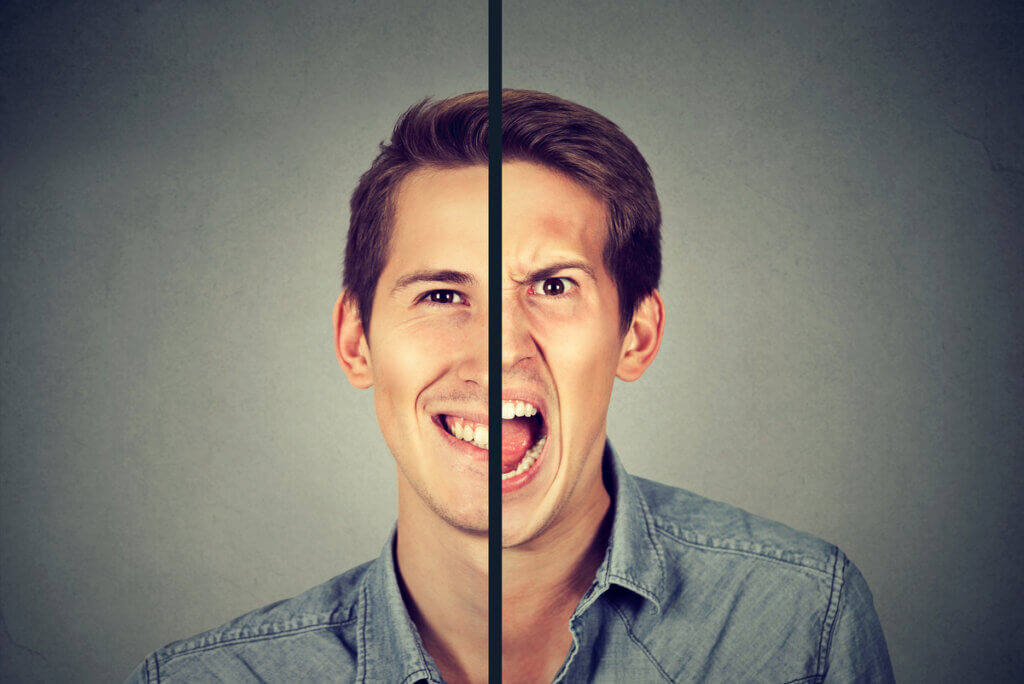Bipolar Disorder: Types, Symptoms, and Causes


Escrito y verificado por la psicóloga Paula Villasante
Bipolar disorder is a chronic relapsing disorder characterized by fluctuations in mood. It affects more than 1% of the world’s population, regardless of their nationality, ethnic origin, or socioeconomic status.
Bipolar disorder is one of the leading causes of disability among young people, leading to cognitive and functional decline. In addition, it also entails an increase in mortality during this vital period, specifically due to suicide.
Typically, it occurs with other associated psychiatric and medical disorders. Its diagnosis is difficult in clinical practice because it starts with a depressive episode that’s very similar to unipolar depression. In addition, currently, there are no valid biomarkers.
That’s why the role of clinical evaluation is so fundamental. Detection of hypomanic periods and longitudinal assessment are crucial in differentiating bipolar disorder from other conditions. Knowledge of pharmacological and psychological strategies is extremely important.
What’s bipolar disorder?
Formerly known as manic-depressive disorder or manic depression, bipolar disorder is an illness that can be chronic or episodic (occur at irregular intervals). It can cause mood swings, which can range from infrequent to extreme.
Types of bipolar disorder
There are three types of bipolar disorder, all of which involve noticeable changes in activity levels, energy, and mood. They can range from more active and optimistic or euphoric behaviors to profound depression, hopelessness, and sadness.
When four or more episodes of mania or depression occur in a year, it’s called rapid cycling. As for the particular types, there are three.

Bipolar I disorder
This type is defined by manic episodes that last at least seven days or if the manic symptoms are so severe that they require medical attention.
Separate depressive episodes usually occur, usually lasting two weeks. There may also be episodes of mood alterations with mixed characteristics, that is, with manic and depressive symptoms occurring at the same time.
Bipolar II disorder
This disorder is defined by a pattern of hypomanic and depressive episodes, but these aren’t extreme as they are in bipolar I disorder.
Cyclothymic disorder (cyclotomy)
In cyclothymia, depressive and hypomanic symptoms persist, but they’re not intense or extensive enough to qualify as depressive or hypomanic episodes as such. Typically, symptoms last for at least two years in adults and one year in children and adolescents.
The symptoms of bipolar disorder
The symptoms of bipolar disorder can vary. Specifically, they differ depending on whether they’re depressive episodes, manic episodes, or mixed episodes.
During episodes, symptoms last most of the day and every day. In any case, the intensity of the signs depends on each particular person. Some may be milder than others.
Depressive episodes
During depressive episodes, symptoms can include feeling hopeless, sad, or irritable most of the time. There’s also slowness or restlessness. The person has trouble falling asleep or sleeps too much.
There’s difficulty concentrating and remembering things, lack of energy, loss of interest in daily activities, and feelings of guilt and despair. They’re sometimes accompanied by delusions, hallucinations, and disturbed or illogical thoughts. There’s a tendency to feel pessimistic about everything, doubting oneself.
Other symptoms are as follows:
- Talk slowly: Feeling like there’s nothing to say or forgetting things
- Lack of appetite
- Suicidal thoughts
Manic episodes
In manic episodes, the patient is very optimistic, talks fast, and feels happy, euphoric, and full of energy. They’re easily distracted and feel that they’re full of new ideas and important plans. They feel startled or nervous and faster than usual.
It can also be accompanied by delusions, hallucinations, and disturbed or illogical thoughts. There’s a lack of appetite or desire to eat too much. Some define it as a flight of ideas, as thoughts go very fast.
They may make decisions or say things that are out of line and that others see as harmful or risky and have an excessive appetite for food, drinks, sex, and other pleasurable activities. Family and friends may notice these symptoms and notice changes in mood and activity levels that show different behavior than usual.
Causes of bipolar disorder
The exact causes of bipolar disorder are unknown. Experts believe that there are a number of factors that work together to cause a person to develop it.
A chemical imbalance in the brain
Bipolar disorder is believed to be the result of chemical imbalances in the brain. The neurotransmitters responsible for controlling brain functions are norepinephrine, dopamine, and serotonin.
There’s evidence that if there’s an imbalance in the levels of one or more neurotransmitters, some symptoms of bipolar disorder may develop. For example, manic episodes occur when norepinephrine levels are too high, and depressive episodes result from low norepinephrine levels.
Genetics
It’s also assumed that bipolar disorder is related to genetics, as there seem to be hereditary indications. Relatives of a person with this condition have a higher risk of developing it themselves. However, there’s no specific gene that’s responsible for bipolar disorder.
Triggers
A stressful circumstance or situation can often trigger the symptoms of bipolar disorder. Some examples of stressful triggers are:
- The breakdown of a physically, sexually, or emotionally abusive relationship.
- The death of a close family member or loved one.
These types of life-altering events cause episodes of depression at any time. In addition, bipolar disorder can also be triggered by sleep disturbances and problems of daily life, such as those related to work, money, and interpersonal relationships.

Diagnosis
To diagnose this disorder, tests can be carried out to rule out other diseases, and these tests are combined with a psychiatric evaluation. It’s very important that there are no delays in detection, as the delay complicates the approach and brings daily consequences for the patient.
It’s not uncommon for bipolar disorder to have symptoms in common with other mental health conditions, such as unipolar depression or schizophrenia. Often these associations make diagnosis difficult.
Many people may suffer from other conditions along with bipolar disorder, such as anxiety, attention deficit hyperactivity disorder, drug or alcohol misuse, bulimia, anorexia, and psychosis.
Psychotic symptoms tend to coincide with the person’s extreme mood. During a depressive episode, they may believe they’re broke and penniless or have committed a crime, while during a manic episode, they may believe themselves to be famous or have special powers.
The treatment of bipolar disorder
If a person with bipolar disorder doesn’t receive treatment, manic episodes can last 3 to 6 months. On the other hand, the stages of depression tend to last longer, often from 6 to 12 months.
Most people with bipolar disorder can be treated using a combination of different approaches. These may include one or more of the following:
- Medications to prevent episodes of mania and depression: These are known as mood stabilizers and are taken every day for a long period of time. The most used is lithium.
- Drugs to treat the main symptoms of depression and mania.
- Psychological treatment: Such as talk therapy, which could help manage depression and provide advice on how to behave at each stage.
- Lifestyle changes: Exercising regularly, planning enjoyable activities, and improving diet.
The difficulties of bipolar disorder
Bipolar disorder is a mental health clinical picture that’s difficult for the patient, for those close to them, and for the treating professionals. Episodes of mania and depression alter the quality of life and can leave a person in economic, professional, and social ruin.
There are various approaches, but all have their limitations. Only a combination of several will be capable of helping the person to achieve a certain level of stability and live a life that’s as normal as possible.
Bipolar disorder is a chronic relapsing disorder characterized by fluctuations in mood. It affects more than 1% of the world’s population, regardless of their nationality, ethnic origin, or socioeconomic status.
Bipolar disorder is one of the leading causes of disability among young people, leading to cognitive and functional decline. In addition, it also entails an increase in mortality during this vital period, specifically due to suicide.
Typically, it occurs with other associated psychiatric and medical disorders. Its diagnosis is difficult in clinical practice because it starts with a depressive episode that’s very similar to unipolar depression. In addition, currently, there are no valid biomarkers.
That’s why the role of clinical evaluation is so fundamental. Detection of hypomanic periods and longitudinal assessment are crucial in differentiating bipolar disorder from other conditions. Knowledge of pharmacological and psychological strategies is extremely important.
What’s bipolar disorder?
Formerly known as manic-depressive disorder or manic depression, bipolar disorder is an illness that can be chronic or episodic (occur at irregular intervals). It can cause mood swings, which can range from infrequent to extreme.
Types of bipolar disorder
There are three types of bipolar disorder, all of which involve noticeable changes in activity levels, energy, and mood. They can range from more active and optimistic or euphoric behaviors to profound depression, hopelessness, and sadness.
When four or more episodes of mania or depression occur in a year, it’s called rapid cycling. As for the particular types, there are three.

Bipolar I disorder
This type is defined by manic episodes that last at least seven days or if the manic symptoms are so severe that they require medical attention.
Separate depressive episodes usually occur, usually lasting two weeks. There may also be episodes of mood alterations with mixed characteristics, that is, with manic and depressive symptoms occurring at the same time.
Bipolar II disorder
This disorder is defined by a pattern of hypomanic and depressive episodes, but these aren’t extreme as they are in bipolar I disorder.
Cyclothymic disorder (cyclotomy)
In cyclothymia, depressive and hypomanic symptoms persist, but they’re not intense or extensive enough to qualify as depressive or hypomanic episodes as such. Typically, symptoms last for at least two years in adults and one year in children and adolescents.
The symptoms of bipolar disorder
The symptoms of bipolar disorder can vary. Specifically, they differ depending on whether they’re depressive episodes, manic episodes, or mixed episodes.
During episodes, symptoms last most of the day and every day. In any case, the intensity of the signs depends on each particular person. Some may be milder than others.
Depressive episodes
During depressive episodes, symptoms can include feeling hopeless, sad, or irritable most of the time. There’s also slowness or restlessness. The person has trouble falling asleep or sleeps too much.
There’s difficulty concentrating and remembering things, lack of energy, loss of interest in daily activities, and feelings of guilt and despair. They’re sometimes accompanied by delusions, hallucinations, and disturbed or illogical thoughts. There’s a tendency to feel pessimistic about everything, doubting oneself.
Other symptoms are as follows:
- Talk slowly: Feeling like there’s nothing to say or forgetting things
- Lack of appetite
- Suicidal thoughts
Manic episodes
In manic episodes, the patient is very optimistic, talks fast, and feels happy, euphoric, and full of energy. They’re easily distracted and feel that they’re full of new ideas and important plans. They feel startled or nervous and faster than usual.
It can also be accompanied by delusions, hallucinations, and disturbed or illogical thoughts. There’s a lack of appetite or desire to eat too much. Some define it as a flight of ideas, as thoughts go very fast.
They may make decisions or say things that are out of line and that others see as harmful or risky and have an excessive appetite for food, drinks, sex, and other pleasurable activities. Family and friends may notice these symptoms and notice changes in mood and activity levels that show different behavior than usual.
Causes of bipolar disorder
The exact causes of bipolar disorder are unknown. Experts believe that there are a number of factors that work together to cause a person to develop it.
A chemical imbalance in the brain
Bipolar disorder is believed to be the result of chemical imbalances in the brain. The neurotransmitters responsible for controlling brain functions are norepinephrine, dopamine, and serotonin.
There’s evidence that if there’s an imbalance in the levels of one or more neurotransmitters, some symptoms of bipolar disorder may develop. For example, manic episodes occur when norepinephrine levels are too high, and depressive episodes result from low norepinephrine levels.
Genetics
It’s also assumed that bipolar disorder is related to genetics, as there seem to be hereditary indications. Relatives of a person with this condition have a higher risk of developing it themselves. However, there’s no specific gene that’s responsible for bipolar disorder.
Triggers
A stressful circumstance or situation can often trigger the symptoms of bipolar disorder. Some examples of stressful triggers are:
- The breakdown of a physically, sexually, or emotionally abusive relationship.
- The death of a close family member or loved one.
These types of life-altering events cause episodes of depression at any time. In addition, bipolar disorder can also be triggered by sleep disturbances and problems of daily life, such as those related to work, money, and interpersonal relationships.

Diagnosis
To diagnose this disorder, tests can be carried out to rule out other diseases, and these tests are combined with a psychiatric evaluation. It’s very important that there are no delays in detection, as the delay complicates the approach and brings daily consequences for the patient.
It’s not uncommon for bipolar disorder to have symptoms in common with other mental health conditions, such as unipolar depression or schizophrenia. Often these associations make diagnosis difficult.
Many people may suffer from other conditions along with bipolar disorder, such as anxiety, attention deficit hyperactivity disorder, drug or alcohol misuse, bulimia, anorexia, and psychosis.
Psychotic symptoms tend to coincide with the person’s extreme mood. During a depressive episode, they may believe they’re broke and penniless or have committed a crime, while during a manic episode, they may believe themselves to be famous or have special powers.
The treatment of bipolar disorder
If a person with bipolar disorder doesn’t receive treatment, manic episodes can last 3 to 6 months. On the other hand, the stages of depression tend to last longer, often from 6 to 12 months.
Most people with bipolar disorder can be treated using a combination of different approaches. These may include one or more of the following:
- Medications to prevent episodes of mania and depression: These are known as mood stabilizers and are taken every day for a long period of time. The most used is lithium.
- Drugs to treat the main symptoms of depression and mania.
- Psychological treatment: Such as talk therapy, which could help manage depression and provide advice on how to behave at each stage.
- Lifestyle changes: Exercising regularly, planning enjoyable activities, and improving diet.
The difficulties of bipolar disorder
Bipolar disorder is a mental health clinical picture that’s difficult for the patient, for those close to them, and for the treating professionals. Episodes of mania and depression alter the quality of life and can leave a person in economic, professional, and social ruin.
There are various approaches, but all have their limitations. Only a combination of several will be capable of helping the person to achieve a certain level of stability and live a life that’s as normal as possible.
- Bipolar disorder – Treatment. (2019). Retrieved 19 October 2020, from https://www.nhs.uk/conditions/bipolar-disorder/treatment/
- Muñoz Larreta, Helena, and Cecilia Nilde Venturino. Factores genéticos y ambientales en el trastorno bipolar. Diss. 2018.
- Freidin, Esteban, Gerardo Fernández, and Daniel Pitón. “Psicopatología y cerebro: desde los demonios a los neurotransmisores.” (2004).
- Figueroa, A., L. Baras, and C. Soutullo. “Trastornos del humor: trastorno depresivo y trastorno bipolar.” Lecciones de psiquiatría (2010): 121-124.
- de Dios, Consuelo, et al. “Los trastornos bipolares en las nuevas clasificaciones: DSM-5 y CIE-11.” Revista de Psiquiatría y Salud Mental 7.4 (2014): 179-185.
- Trastorno bipolar: MedlinePlus en español. (2020). Retrieved 19 October 2020, from https://medlineplus.gov/spanish/bipolardisorder.html
- Arias, Francisco, et al. “Trastorno bipolar y trastorno por uso de sustancias. Estudio Madrid sobre prevalencia de patología dual.” Adicciones 29.3 (2017): 186-194.
- NIMH » Trastorno bipolar. (2019). Retrieved 19 October 2020, from https://www.nimh.nih.gov/health/publications/espanol/trastorno-bipolar/index.shtml
-
Vieta, E., Berk, M., Birmaher, B., & Grande, I. (2016). Bipolar disorder: defining symptoms and comorbidities–Authors’ reply. The Lancet, 388(10047), 869-870.
- García-Blanco, Ana C., Pilar Sierra, and Lorenzo Livianos. “Nosología, epidemiología y etiopatogenia del trastorno bipolar: Últimas aproximaciones.” Psiquiatría biológica 21.3 (2014): 89-94.
- Goikolea, Jose Manuel, and Marc Valentí. “Actualización del tratamiento del trastorno bipolar.” Revista Jano 1.714 (2008): 31-34.
Este texto se ofrece únicamente con propósitos informativos y no reemplaza la consulta con un profesional. Ante dudas, consulta a tu especialista.







